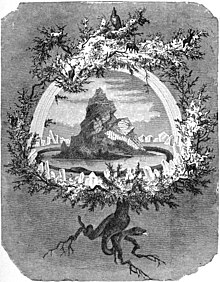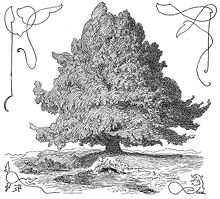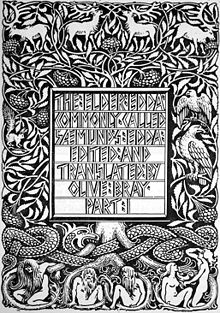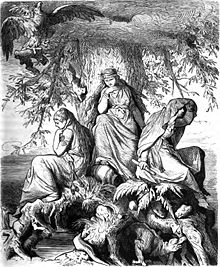Yggdrasil

Yggdrasil(fromOld NorseYggdrasill) is an immense and centralsacred treeinNorse cosmology.Around it exists all else, including theNine Worlds.
Yggdrasil is attested in thePoetic Eddacompiled in the 13th century from earlier traditional sources, and in theProse Eddacompiled in the 13th century bySnorri Sturluson.In both sources, Yggdrasil is an immenseash treethat is central to the cosmos and considered very holy. Thegodsgo to Yggdrasil daily to assemble at theirtraditional governing assemblies.The branches of Yggdrasil extend far into the heavens, and the tree is supported by three roots that extend far away into other locations; one to the wellUrðarbrunnrin the heavens, one to the springHvergelmir,and another to the wellMímisbrunnr.Creatures live within Yggdrasil, including the dragonNíðhöggr,anunnamed eagle,and the stagsDáinn, Dvalinn, Duneyrr and Duraþrór.
Scholars generally considerHoddmímis holt,Mímameiðr,andLæraðrto be other names for the tree. The tree is an example ofsacred trees and groves in Germanic paganism and mythology,and scholars in the field ofGermanic philologyhave long discussed its implications.
Etymology
[edit]
The generally accepted meaning of Old NorseYggdrasillis "Odin's horse", meaning "gallows".This interpretation comes about becausedrasillmeans "horse" andYgg(r)is one ofOdin's many names.ThePoetic EddapoemHávamáldescribes how Odin sacrificed himself by hanging from a tree, making this tree Odin's gallows. This tree may have been Yggdrasil. "The horse of the hanged" is akenningfor gallows and therefore Odin's gallows may have developed into the expression "Odin's horse", which then became the name of the tree.[1]
Nevertheless, scholarly opinions regarding the precise meaning of the nameYggdrasillvary, particularly on the issue of whetherYggdrasillis the name of the tree itself or if only the full termaskr Yggdrasil(where Old Norseaskrmeans "ash tree" ) refers specifically to the tree. According to this interpretation,askr Yggdrasilswould mean theworld treeupon which "the horse [Odin's horse] of the highest god [Odin] is bound". Both of these etymologies rely on a presumed but unattested*Yggsdrasill.[1]
A third interpretation, presented by F. Detter, is that the nameYggdrasillrefers to the wordyggr( "terror" ), yet not in reference to the Odinic name, and soYggdrasillwould then mean "tree of terror, gallows". F. R. Schröder has proposed a fourth etymology according to whichyggdrasillmeans "yew pillar", derivingyggiafrom*igwja(meaning "yew-tree"), anddrasillfrom*dher-(meaning "support" ).[1]
Attestations
[edit]Poetic Edda
[edit]In thePoetic Edda,the tree is mentioned in the three poemsVöluspá,HávamálandGrímnismál.
Völuspá
[edit]
In the second stanza of thePoetic EddapoemVöluspá,thevölva(a shamanic seeress) reciting the poem to the god Odin says that she remembers far back to "early times", being raised byjötnar,recallsnine worldsand nineídiðiur(rendered in a variety of ways by translators—Dronke, for example, provides "nine wood-ogresses" ), and when Yggdrasil was a seed ( "glorious tree of good measure, under the ground" ).[2]In stanza 19, the völva says:
An ash I know there stands,
Yggdrasill is its name,
a tall tree, showered
with shiningloam.
From there come the dews
that drop in the valleys.
It stands forever green over
Urðr's well.[3]
In stanza 20, the völva says that from the lake under the tree come three "maidens deep in knowledge" namedUrðr,Verðandi,andSkuld.The maidens "incised the slip of wood", "laid down laws" and "chose lives" for the children of mankind and the destinies (ørlǫg) of men.[4]In stanza 27, the völva details that she is aware that "Heimdallr's hearing is couched beneath the bright-nurtured holy tree. "[5]In stanza 45, Yggdrasil receives a final mention in the poem. The völva describes, as a part of the onset of Ragnarök, that Heimdallr blowsGjallarhorn,that Odin speaks withMímir's head, and then:
Yggdrasill shivers,
the ash, as it stands.
The old tree groans,
and the giant slips free.[6]
Hávamál
[edit]
In stanza 138 of the poemHávamál,Odin describes how he once sacrificed himself to himself by hanging on a tree. The stanza reads:
In the stanza that follows, Odin describes how he had no food nor drink there, that he peered downward, and that "I took up therunes,screaming I took them, then I fell back from there. "[7]Odin later used "the knowledge of the sacred runes" as a magical tool to give to mankind to increase humans' skill in magic and poetry.[8]
While Yggdrasil is not mentioned by name in the poem and other trees exist in Norse mythology, the tree is near universally accepted as Yggdrasil by scholars, and if the tree is Yggdrasil, then the nameYggdrasildirectly relates to this story.[9]
Grímnismál
[edit]In the poemGrímnismál,Odin (disguised asGrímnir) provides the youngAgnarwith cosmological lore. Yggdrasil is first mentioned in the poem in stanza 29, where Odin says that, because the "bridge of the Æsirburns "and the"sacred watersboil, "Thormust wade through the riversKörmt and Örmtand two rivers namedKerlaugarto go "sit as judge at the ash of Yggdrasill". In the stanza that follows, alist of names of horsesare given that the Æsir ride to "sit as judges" at Yggdrasil.[10]
In stanza 31, Odin says that the ash Yggdrasil has three roots that grow in three directions. He details that beneath the first livesHel,under the second live frost jötnar, and beneath the third lives mankind. Stanza 32 details that a squirrel namedRatatoskrmust run across Yggdrasil and bring "the eagle's word" from above to Níðhöggr below. Stanza 33 describes that fourhartsnamed Dáinn, Dvalinn, Duneyrr and Duraþrór consume "the highest boughs" of Yggdrasil.[10]
In stanza 34, Odin says that more serpents lie beneath Yggdrasil "than any fool can imagine" and lists them as Góinn and Móinn (possibly meaning Old Norse "land animal"[11]), which he describes as sons of Grafvitnir (Old Norse, possibly "ditch wolf"[12]), Grábakr (Old Norse "Greyback"[11]), Grafvölluðr (Old Norse, possibly "the one digging under the plain" or possibly amended as "the one ruling in the ditch"[12]), Ófnir (Old Norse "the winding one, the twisting one"[13]), and Sváfnir (Old Norse, possibly "the one who puts to sleep = death"[14]), who Odin adds that he thinks will forever gnaw on the tree's branches.[10]
In stanza 35, Odin says that Yggdrasil "suffers agony more than men know", as a hart bites it from above, it decays on its sides, and Níðhöggr bites it from beneath.[15]In stanza 44, Odin provides a list of things that are what he refers to as the "noblest" of their kind. Within the list, Odin mentions Yggdrasil first, and states that it is the "noblest of trees".[16]
Prose Edda
[edit]

Yggdrasil is mentioned in two books in theProse Edda;GylfaginningandSkáldskaparmál.InGylfaginning,Yggdrasil is introduced in chapter 15. In chapter 15,Gangleri(described as kingGylfiin disguise) asks where is the chief or holiest place of the gods.Highreplies "It is the ash Yggdrasil. There the gods must hold their courts each day". Gangleri asks what there is to tell about Yggdrasil.Just-As-Highsays that Yggdrasil is the biggest and best of all trees, that its branches extend out over all of the world and reach out over the sky. Three of the roots of the tree support it, and these three roots also extend extremely far: one "is among theÆsir,the second among the frost jötnar, and the third overNiflheim.The root over Niflheim is gnawed at by the wyrmNíðhöggr,and beneath this root is the springHvergelmir.Beneath the root that reaches the frost jötnar is the wellMímisbrunnr,"which has wisdom and intelligence contained in it, and the master of the well is calledMimir".Just-As-High provides details regarding Mímisbrunnr and then describes that the third root of the well" extends to heaven "and that beneath the root is the" very holy "wellUrðarbrunnr.At Urðarbrunnr the gods hold their court, and every day the Æsir ride to Urðarbrunnr up over the bridgeBifröst.Later in the chapter, a stanza fromGrímnismálmentioning Yggdrasil is quoted in support.[17]
In chapter 16, Gangleri asks "what other particularly notable things are there to tell about the ash?" High says there is quite a lot to tell about. High continues that an eagle sits on the branches of Yggdrasil and that it has much knowledge. Between the eyes of the eagle sits a hawk calledVeðrfölnir.A squirrel calledRatatoskrscurries up and down the ash Yggdrasil carrying "malicious messages" between the eagle and Níðhöggr. Four stags named Dáinn, Dvalinn, Duneyrr, and Duraþrór run between the branches of Yggdrasil and consume its foliage. In the spring Hvergelmir are so many snakes along with Níðhöggr "that no tongue can enumerate them". Two stanzas fromGrímnismálare then cited in support. High continues that the norns that live by the holy well Urðarbrunnr each day take water from the well and mud from around it and pour it over Yggdrasil so that the branches of the ash do not rot away or decay. High provides more information about Urðarbrunnr, cites a stanza fromVöluspáin support, and adds thatdewfalls from Yggdrasil to the earth, explaining that "this is what people callhoneydew,and from it bees feed ".[18]
In chapter 41, the stanza fromGrímnismális quoted that mentions that Yggdrasil is the foremost of trees.[19]In chapter 54, as part of the events ofRagnarök,High describes that Odin will ride to the well Mímisbrunnr and consult Mímir on behalf of himself and his people. After this, "the ash Yggdrasil will shake and nothing will be unafraid in heaven or on earth", and then the Æsir andEinherjarwill don their war gear and advance to the field ofVígríðr.Further into the chapter, the stanza inVöluspáthat details this sequence is cited.[20]
In theProse EddabookSkáldskaparmál,Yggdrasil receives a single mention, though not by name. In chapter 64, names forkingsanddukesare given. "Illustrious one" is provided as an example, appearing in a Christianity-influenced work by theskaldHallvarðr Háreksblesi:"There is not under the pole of the earth [Yggdrasil] an illustrious one closer to the lord ofmonks[God] than you. "[21]
Theories
[edit]Shamanic origins
[edit]Hilda Ellis Davidsoncomments that the existence of nine worlds around Yggdrasil is mentioned more than once in Old Norse sources, but the identity of the worlds is never stated outright, though it can be deduced from various sources. Davidson comments that "no doubt the identity of the nine varied from time to time as the emphasis changed or new imagery arrived". Davidson says that it is unclear where the nine worlds are located in relation to the tree; they could either exist one above the other or perhaps be grouped around the tree, but there are references to worlds existing beneath the tree, while the gods are pictured as in the sky, a rainbow bridge (Bifröst) connecting the tree with other worlds. Davidson opines that "those who have tried to produce a convincing diagram of theScandinaviancosmos from what we are told in the sources have only added to the confusion ".[22]
Davidson notes parallels between Yggdrasil andshamaniclore in northern Eurasia:
The conception of the tree rising through a number of worlds is found in northern Eurasia and forms part of the shamanic lore shared by many peoples of this region. This seems to be a very ancient conception, perhaps based on thePole Star,the centre of the heavens, and the image of the central tree in Scandinavia may have been influenced by it.... AmongSiberianshamans, a central tree may be used as a ladder to ascend the heavens.[22]
Davidson says that the notion of an eagle atop a tree and the world serpent coiled around the roots of the tree has parallels in other cosmologies fromAsia.She goes on to say that Norse cosmology may have been influenced by these Asiatic cosmologies from a northern location. Davidson adds, on the other hand, that it is attested that theGermanic peoplesworshiped their deities in open forest clearings and that asky godwas particularly connected with theoaktree, and therefore "a central tree was a natural symbol for them also".[22]
Mímameiðr, Hoddmímis holt, and Ragnarök
[edit]
Connections have been proposed between the woodHoddmímis holt(Old Norse"Hoard-Mímir's "[23]holt) and the treeMímameiðr( "Mímir's tree" ), generally thought to refer to the world tree Yggdrasil, and the springMímisbrunnr.[23]John Lindow concurs thatMímameiðrmay be another name for Yggdrasil and that if the Hoard-Mímir of the nameHoddmímis holtis the same figure asMímir(associated with the spring named after him, Mímisbrunnr), then the Mímir's holt—Yggdrasil—and Mímir's spring may be within the same proximity.[24]
Carolyne Larrington notes that it is nowhere expressly stated what will happen to Yggdrasil during the events ofRagnarök.Larrington points to a connection between the primordial figure ofMímirand Yggdrasil in the poemVöluspá,and theorizes that "it is possible that Hoddmimir is another name for Mimir, and that thetwo survivorshide in Yggdrasill. "[25]
Rudolf Simektheorizes that the survival ofLíf and Lífþrasirthrough Ragnarök by hiding in Hoddmímis holt is "a case of reduplication of the anthropogeny, understandable from the cyclic nature of the Eddic eschatology". Simek says that Hoddmímis holt "should not be understood literally as a wood or even a forest in which the two keep themselves hidden, but rather as an alternative name for the world-tree Yggdrasill. Thus, the creation of mankind from tree trunks (Askr, Embla) is repeated after the Ragnarǫk as well." Simek says that inGermanic regions,the concept of mankind originating from trees is ancient. Simek additionally points out legendary parallels in aBavarianlegend of ashepherdwho lives inside a tree, whose descendants repopulate the land after life there has been wiped out by plague (citing a retelling by F. R. Schröder). In addition, Simek points to an Old Norse parallel in the figure ofÖrvar-Oddr,"who is rejuvenated after living as a tree-man (Ǫrvar-Odds saga24–27) ".[26]
Warden trees, Irminsul, and sacred trees
[edit]
aNordic Bronze Ageburial moundinRoskilde,Denmark
Continuing as late as the 19th century,warden treeswere venerated in areas of Germany and Scandinavia, considered to be guardians and bringers of luck, and offerings were sometimes made to them. A massivebirchtree standing atop aburial moundand located beside a farm in westernNorwayis recorded as having had ale poured over its roots during festivals. The tree was felled in 1874.[27]
Davidson comments that "the position of the tree in the centre as a source of luck and protection for gods and men is confirmed" by these rituals to Warden Trees. Davidson notes that the gods are described as meeting beneath Yggdrasil to hold theirthings,and the relatedIrminsul,which may have been a pillar, was also symbolic of the center of the world. Davidson details that it would be difficult to ascertain whether a tree or pillar came first, and that this is likely to depend on whether the holy location was in a thickly wooded area or not. Davidson notes that there is no mention of asacred treeatÞingvellirinIceland,but thatAdam of Bremendescribes ahuge tree standing next to the Temple at UppsalainSweden,which remained green throughout summer and winter, and that no one knew what type it was. Davidson comments that while it is uncertain if Adam's informant actually witnessed the tree, the existence of sacred trees in pre-Christian Germanic Europe is further evidenced by records of their destruction by early Christian missionaries, such asThor's OakbySaint Boniface.[27]
Ken Dowdencomments that behind Irminsul, Thor's Oak in Geismar, and the sacred tree atUppsala"looms a mythic prototype, an Yggdrasil, the world-ash of theNorsemen".[28]
Modern influence
[edit]Thomas Carlyleadopted "Igdrasil" as a favorite symbol; it features in bothOn Heroes, Hero-Worship, & the Heroic in History(1841) andPast and Present(1843).John Ruskinreferenced it in the conclusion toThe Laws ofFésole(1877–1878). An unpublished manuscript of Carlyle's entitled "Igdrasil. From the Norse"[29]inspired the editor ofThe Ruskin ReadingGuildJournalto addIgdrasilto its name in 1890.[30]
Modern works of art depicting Yggdrasil includeDie Nornen(painting, 1888) by K. Ehrenberg;Yggdrasil(fresco,1933) byAxel Revold,located in theUniversity of Oslolibrary auditorium inOslo,Norway;Hjortene beiter i løvet på Yggdrasil asken(woodrelief carving,1938) on theOslo City HallbyDagfin Werenskiold;and the bronze relief on the doors of theSwedish Museum of National Antiquities(around 1950) by B. Marklund inStockholm,Sweden.
Poems mentioning Yggdrasil includeVårdträdetbyViktor RydbergandYggdrasillby J. Linke.[31]
InOverlord,a Japanese light novel series written by Kugane Maruyama,Yggdrasilis the name of a popularDMMORPG,where the protagonist got trapped after its shutdown.[32]
Yggdrasil is a common motif inMarvel Cinematic Universemedia, appearing inThor,Captain America: The First Avenger,Thor: The Dark World,andLoki.[33][34]
See also
[edit]- Axis mundi,mythological concept representing "the connection between the higher and lower realms"
- Yggdrasil Linux/GNU/X
Notes
[edit]- ^abcSimek 2007,p. 375.
- ^Dronke 1997,p. 7.
- ^Dronke 1997,p. 11–12.
- ^Dronke 1997,p. 12.
- ^Dronke 1997,p. 14.
- ^Dronke 1997,p. 19.
- ^abLarrington 1999,p. 34.
- ^Carlson, Kathie; Flanagin, Michael N.; Martin, Kathleen; Martin, Mary E.; Mendelsohn, John; Rodgers, Priscilla Young; Ronnberg, Ami; Salman, Sherry; Wesley, Deborah A. (2010). Arm, Karen; Ueda, Kako; Thulin, Anne; Langerak, Allison; Kiley, Timothy Gus; Wolff, Mary (eds.).The Book of Symbols: Reflections on Archetypal Images.Köln:Taschen.p. 494.ISBN978-3-8365-1448-4.
- ^Lindow 2001,p. 321.
- ^abcLarrington 1999,p. 56.
- ^abSimek 2007,p. 115.
- ^abSimek 2007,p. 116.
- ^Simek 2007,p. 252.
- ^Simek 2007,p. 305.
- ^Larrington 1999,p. 57.
- ^Larrington 1999,p. 58.
- ^Faulkes 1995,p. 17.
- ^Faulkes 1995,p. 18–19.
- ^Faulkes 1995,p. 34.
- ^Faulkes 1995,p. 54.
- ^Faulkes 1995,p. 146.
- ^abcDavidson 1993,p. 69.
- ^abSimek 2007,p. 154.
- ^Lindow 2001,p. 179.
- ^Larrington 1999,p. 269.
- ^Simek 2007,p. 189;Schröder 1931.
- ^abDavidson 1993,p. 170.
- ^Dowden 2000,p. 72.
- ^Carlyle, Thomas (2009). "Appendix: Igdrasil. From the Norse".Carlyle Studies Annual(25): 59–60.ISSN1074-2670.JSTOR26593166.
- ^Nixon, Jude V. (2009). "Thomas Carlyle's Igdrasil".Carlyle Studies Annual(25). Saint Joseph's University Press: 49–58.ISSN1074-2670.JSTOR26593165.
- ^Simek 2007,p. 376.
- ^"The Summer 2015 Anime Preview Guide – Overlord".Anime News Network.7 July 2015.Archivedfrom the original on 6 May 2019.Retrieved17 June2019.
- ^"Yggdrasil, The World Tree".Zimbio.12 August 2015.Archivedfrom the original on 25 April 2023.Retrieved26 April2023.
- ^Lacson, Therese (10 November 2023)."'Loki' Season 2 Finale Recap: A Glorious Purpose at the End of Time ".Collider.Retrieved14 November2023.
References
[edit]- Davidson, Hilda Ellis(1993).The Lost Beliefs of Northern Europe.Routledge.ISBN0-203-40850-0.
- Dowden, Ken(2000).European Paganism: the Realities of Cult from Antiquity to the Middle Ages.Routledge.ISBN0-415-12034-9.
- Dronke, Ursula(1997).The Poetic Edda: Volume II: Mythological Poems.Oxford University Press.ISBN0-19-811181-9.
- Larrington, Carolyne (Trans.) (1999).The Poetic Edda.Oxford World's Classics.ISBN0-19-283946-2.
- Lindow, John(2001).Norse Mythology: A Guide to the Gods, Heroes, Rituals, and Beliefs.Oxford University Press.ISBN0-19-515382-0.
- Faulkes, Anthony (Trans.) (1995).Edda.Everyman.ISBN0-4608-7616-3.
- Schön, Ebbe(2004).Asa-Tors hammare, Gudar och Jättar i tro och Tradition.Fält & Hässler, Värnamo.ISBN91-89660-41-2.
- Schröder, Franz Rolf (1931). "Germanische Schöpfungsmythen".Germanisch-Romanische Monatsschrift.19:1–26.
- Simek, Rudolf(2007).Dictionary of Northern Mythology.Translated by Angela Hall.D.S. Brewer.ISBN978-0-85991-513-7.



